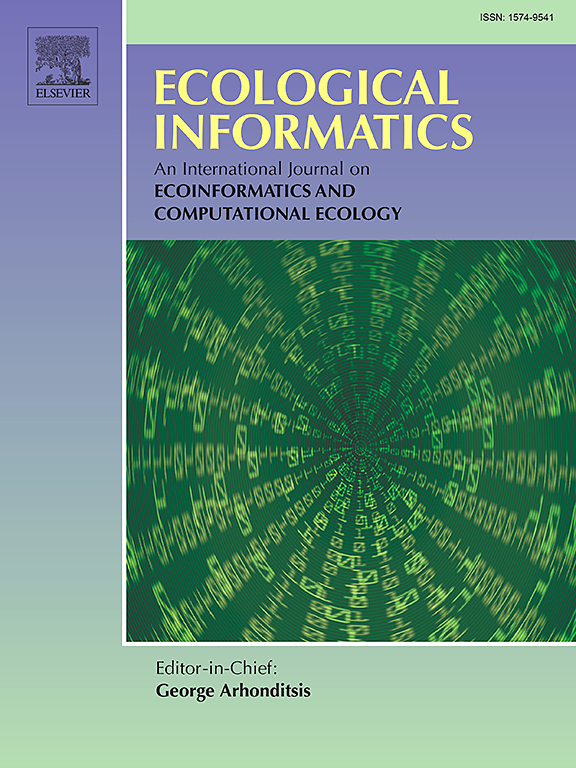基于定制Sentinel-2复合材料的常绿叶片类型分类的时间概化研究
IF 5.8
2区 环境科学与生态学
Q1 ECOLOGY
引用次数: 0
摘要
大规模森林生态系统制图主要依赖于通过先进的遥感技术区分落叶和非落叶树木覆盖。现有的制图方法经常受到空间分辨率的限制和时间的限制。然而,精确、高保真的森林覆盖特征对于森林管理、生态监测和保护规划至关重要。在这项研究中,我们采用了一种新的方法来分类叶片类型——常绿与落叶——使用10米分辨率的Sentinel-2多光谱卫星图像和机器学习,目的是加强预测的鲁棒性,并在对多年数据进行训练时消除对未见年份的再训练的需要。主要贡献包括递归特征消除以识别最相关的光谱带和指数,以及优化合成方法以提高分类精度,平衡鲁棒性和时间细节。在巴伐利亚严格森林保护区48个地区(2019年至2023年)的16,162棵树冠上对8个机器学习模型进行了调整和训练,并使用ForestGEO Traunstein森林动态图地面真实数据(2018年)进行了验证。我们在测试区域的F1得分为0.863,准确率为0.839。重要的是,我们发现模型的性能随着树高的增加而显著提高,这使得我们推荐我们的方法用于树高超过20米的树。结果与哥白尼高分辨率层优势叶型产品进行了基准测试,我们的最佳表现模型在两个指标上都超过了哥白尼产品。这种数据驱动的方法提供了一种具有时间概化的可扩展解决方案,利用免费获得的卫星图像和云计算,有助于更有效地进行森林管理和环境监测。本文章由计算机程序翻译,如有差异,请以英文原文为准。
Temporal generalization in evergreen leaf type classification using tailored Sentinel-2 composites
Large-scale forest ecosystem mapping relies critically on distinguishing deciduous and non-deciduous tree cover through advanced remote sensing technologies. Existing mapping approaches frequently suffer from spatial resolution limitations and temporal constraints. However, precise, high-fidelity forest cover characterizations are essential for forest management, ecological monitoring, and conservation planning. In this study we applied a novel methodology for classifying leaf types – evergreen versus deciduous – using Sentinel-2 multispectral satellite imagery at 10 meter resolution and machine learning, with the aim of strengthening the robustness of predictions and eliminating the need for retraining for unseen years when training on multi-year data. Key contributions include recursive feature elimination to identify the most relevant spectral bands and indices, and optimizing compositing methods to boost classification accuracy, balancing robustness and temporal detail. Eight machine learning models were tuned and trained on 16,162 tree crowns across 48 areas in Bavarian strict forest reserves (2019 to 2023) and validated with ForestGEO Traunstein Forest Dynamics Plot ground truth data (2018). We achieved an F1 score of 0.863 and an accuracy of 0.839 on the test area. Importantly, we found that model performance improved markedly with tree height, leading us to recommend our methodology for trees taller than 20 m. Results were benchmarked against the Copernicus High Resolution Layer Dominant Leaf Type product, with our top-performing model surpassing the Copernicus product in both metrics. This data-driven approach provides a scalable solution with temporal generalization, leveraging freely available satellite imagery and cloud-compute, aiding more effective forest management and environmental monitoring.
求助全文
通过发布文献求助,成功后即可免费获取论文全文。
去求助
来源期刊

Ecological Informatics
环境科学-生态学
CiteScore
8.30
自引率
11.80%
发文量
346
审稿时长
46 days
期刊介绍:
The journal Ecological Informatics is devoted to the publication of high quality, peer-reviewed articles on all aspects of computational ecology, data science and biogeography. The scope of the journal takes into account the data-intensive nature of ecology, the growing capacity of information technology to access, harness and leverage complex data as well as the critical need for informing sustainable management in view of global environmental and climate change.
The nature of the journal is interdisciplinary at the crossover between ecology and informatics. It focuses on novel concepts and techniques for image- and genome-based monitoring and interpretation, sensor- and multimedia-based data acquisition, internet-based data archiving and sharing, data assimilation, modelling and prediction of ecological data.
 求助内容:
求助内容: 应助结果提醒方式:
应助结果提醒方式:


